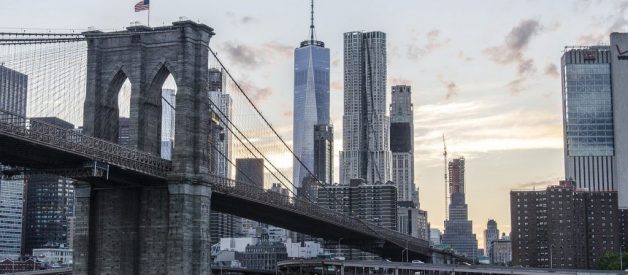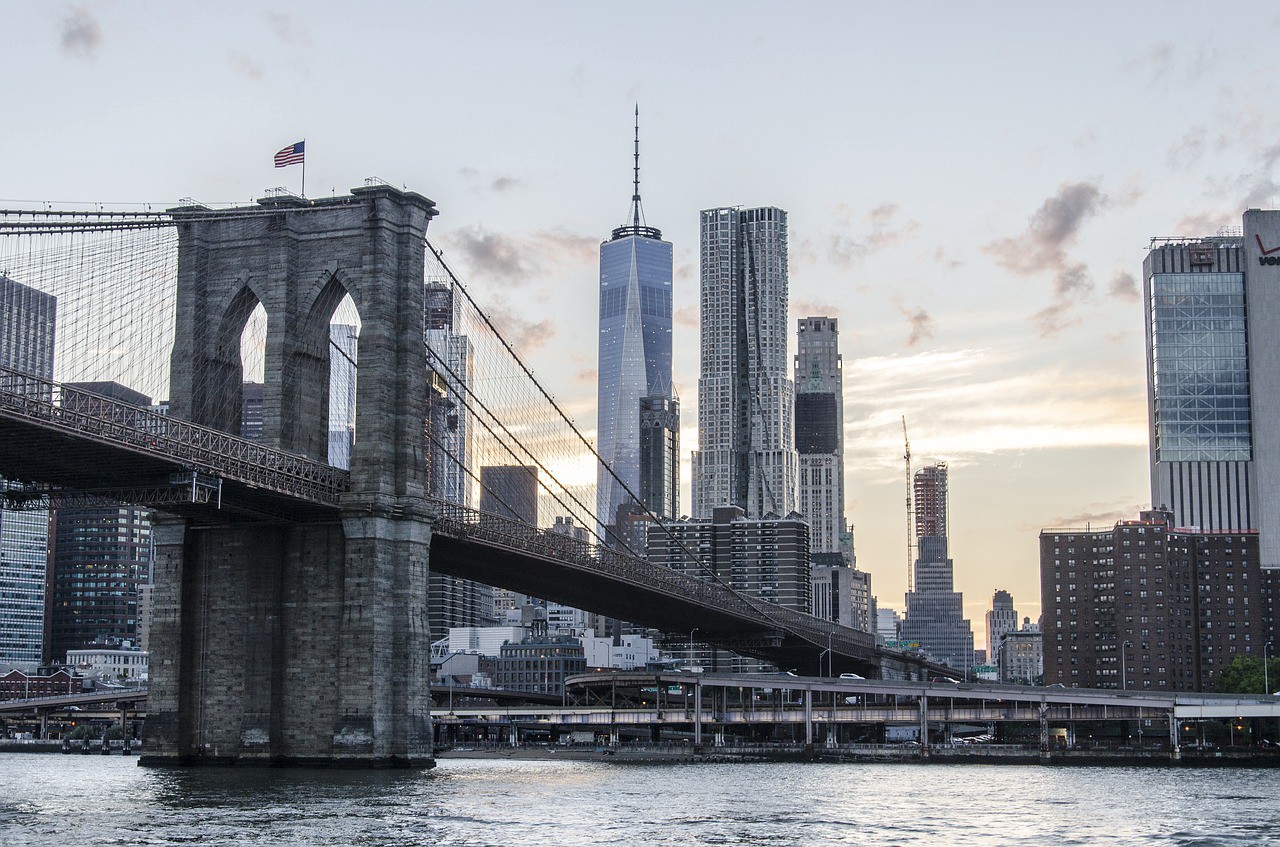
Ever wondered how many bridges are in New York City? Don?t be surprised, but there is actually about 2000 tunnels and bridges that connect all five boroughs. You know, when your city is made of islands, you?re going to need a bridge or two to get around. However, there?s about ten iconic bridges in NYC that connect the five boroughs and areas of NYC themself.
The Brooklyn Bridge
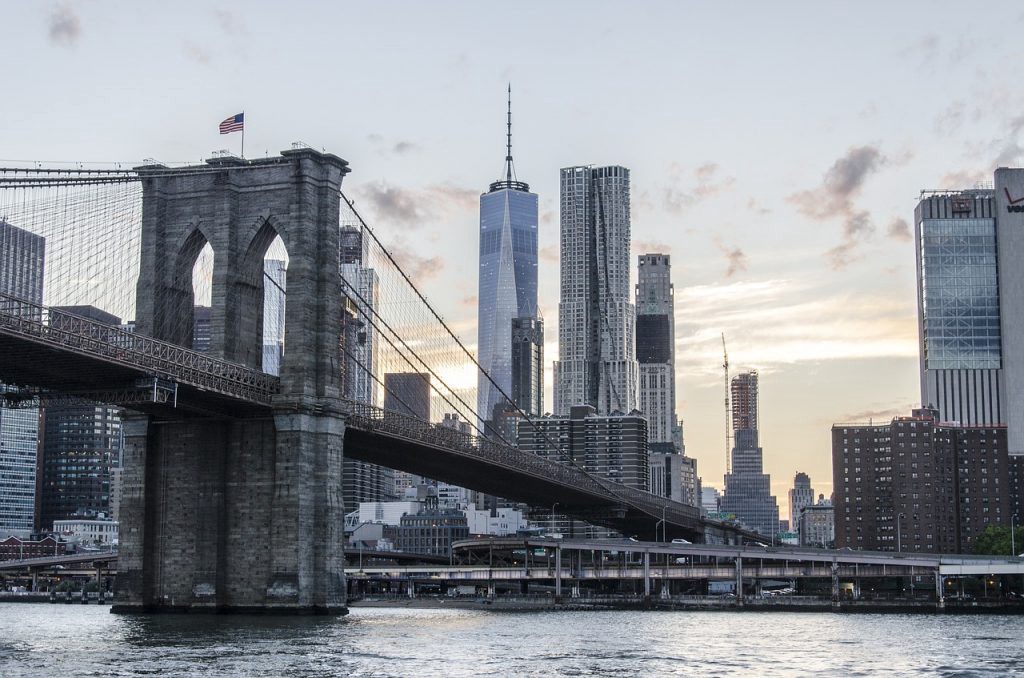 How Many Bridges Are in New York City? The Brooklyn Bridge
How Many Bridges Are in New York City? The Brooklyn Bridge
The Brooklyn Bridge is a hybrid cable-stayed/suspension bridge in New York City, spanning the East River between the boroughs of Manhattan and Brooklyn. Opened on May 24, 1883, the Brooklyn Bridge was the first fixed crossing across the East River. It was also the longest suspension bridge in the world at the time, with a main span of 1,595.5 feet (486.3 m) and a deck height of 127 ft (38.7 m) above mean high water. The span was originally called the New York and Brooklyn Bridge or the East River Bridge but was officially renamed the Brooklyn Bridge in 1915.
Proposals for a bridge connecting Manhattan and Brooklyn were first made in the early 19th century, which eventually led to the construction of the current span, designed by John A. Roebling. His son Washington Roebling oversaw the construction and contributed further design work, assisted by the latter?s wife, Emily Warren Roebling. While construction started in 1870, numerous controversies and the novelty of the designed construction process caused the actual construction to be prolonged over thirteen years. Since opening, the Brooklyn Bridge has undergone several reconfigurations, having carried horse-drawn vehicles and elevated railway lines until 1950. To alleviate increasing traffic flows, numerous bridges and tunnels were built to the north and south. Following gradual deterioration, the Brooklyn Bridge has been renovated several times, including in the 1950s, 1980s, and 2010s.
A major tourist attraction since its opening, the Brooklyn Bridge has become an icon of New York City. Over the years, the bridge has been used as the location of various stunts and performances, as well as several crimes and attacks. The Brooklyn Bridge has been designated a National Historic Landmark, a New York City landmark, and a National Historic Civil Engineering Landmark.
The Verrazzano-Narrows Bridge
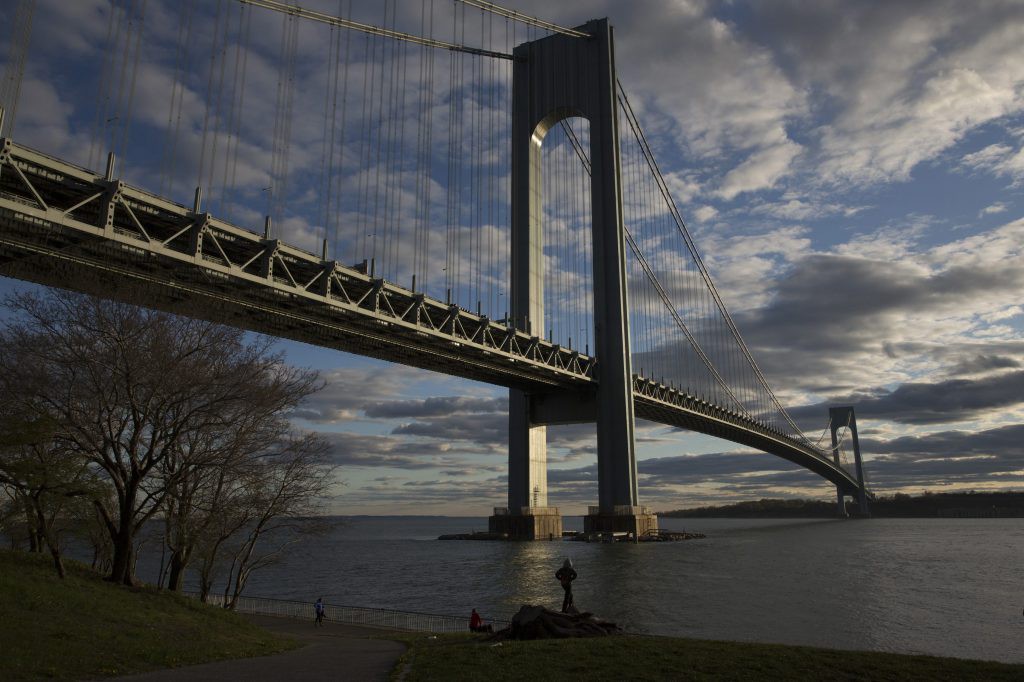 How Many Bridges Are in New York City? The Verrazzano-Narrows Bridge
How Many Bridges Are in New York City? The Verrazzano-Narrows Bridge
The Verrazzano-Narrows Bridge is the longest suspension bridge in the Western Hemisphere, connecting the New York City boroughs of Staten Island and Brooklyn. It spans the Narrows, a body of water linking the relatively enclosed Upper New York Bay with Lower New York Bay and the Atlantic Ocean, and is the only fixed crossing of the Narrows. The double-deck bridge carries 13 lanes of Interstate 278, with seven lanes on the upper level and six on the lower level. The span is named for Giovanni da Verrazzano, the first documented European explorer to enter New York Harbor and the Hudson River in 1524.
Engineer David B. Steinman proposed a bridge across the Narrows in the late 1920s, and subsequent proposals were deferred over the next 20 years. A 1920s attempt to build a rail tunnel under the Narrows was aborted, as was another 1930s plan for vehicular tubes underneath the Narrows. Discussion of a tunnel resurfaced in the mid-1930s and early 1940s, but the plans were again denied. In the late 1940s, urban planner Robert Moses championed a bridge across the Narrows as a way to connect Staten Island with the rest of the city. Various issues delayed the start of construction until 1959. The bridge opened on November 21, 1964, and a lower deck was opened in June 1969 to alleviate high levels of traffic. The New York City government began a $1.5 billion reconstruction of the bridge?s two decks in 2014.
The Verrazzano-Narrows Bridge has a central span of 4,260 feet (1.30 km; 0.81 mi). It was the longest suspension bridge in the world until it was surpassed by the Humber Bridge in the United Kingdom in 1981. The bridge has the 14th-longest main span in the world, as well as the longest in America.
The Queensboro Bridge
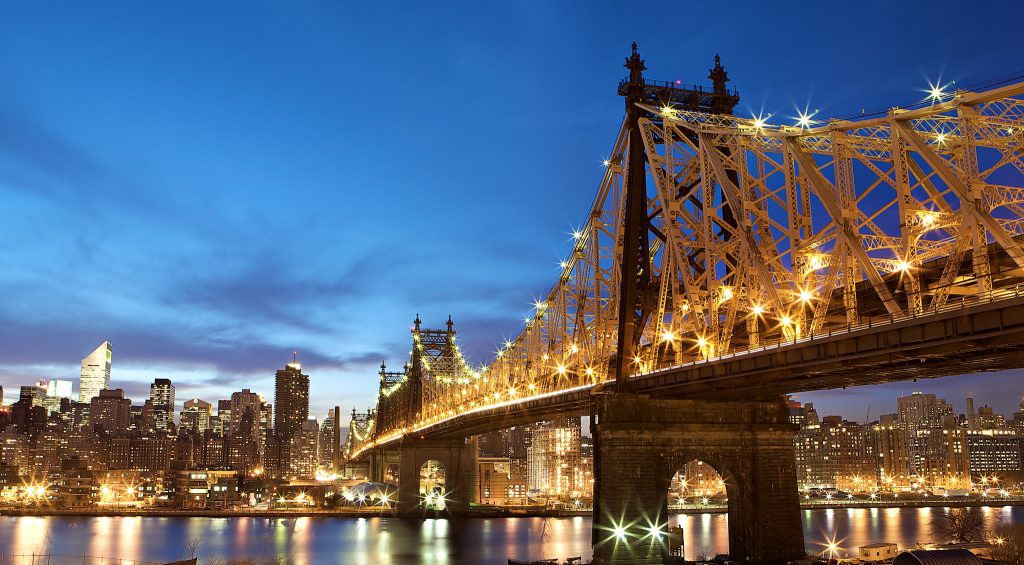 How Many Bridges Are in New York City? The Queensboro Bridge
How Many Bridges Are in New York City? The Queensboro Bridge
The Queensboro Bridge, also known as the 59th Street Bridge ? because its Manhattan end is located between 59th and 60th Streets ? and officially named the Ed Koch Queensboro Bridge, is a cantilever bridge over the East River in New York City. It connects the neighborhood of Long Island City in the borough of Queens with the Upper East Side in Manhattan, passing over Roosevelt Island. The bridge was completed in 1909.
The Queensboro Bridge carries New York State Route 25, which terminates at the bridge?s western end in Manhattan, and also once carried NY 24 and NY 25A. The western leg of the Queensboro Bridge is flanked on its northern side by the freestanding Roosevelt Island Tramway.
The Queensboro Bridge is the northernmost of four toll-free vehicular bridges connecting Manhattan Island to Long Island, along with the Williamsburg, Manhattan, and Brooklyn Bridges to the south. It is the first entry point into Manhattan in the course of the New York City Marathon and the last exit point out of Manhattan in the Five Boro Bike Tour.
The George Washington Bridge
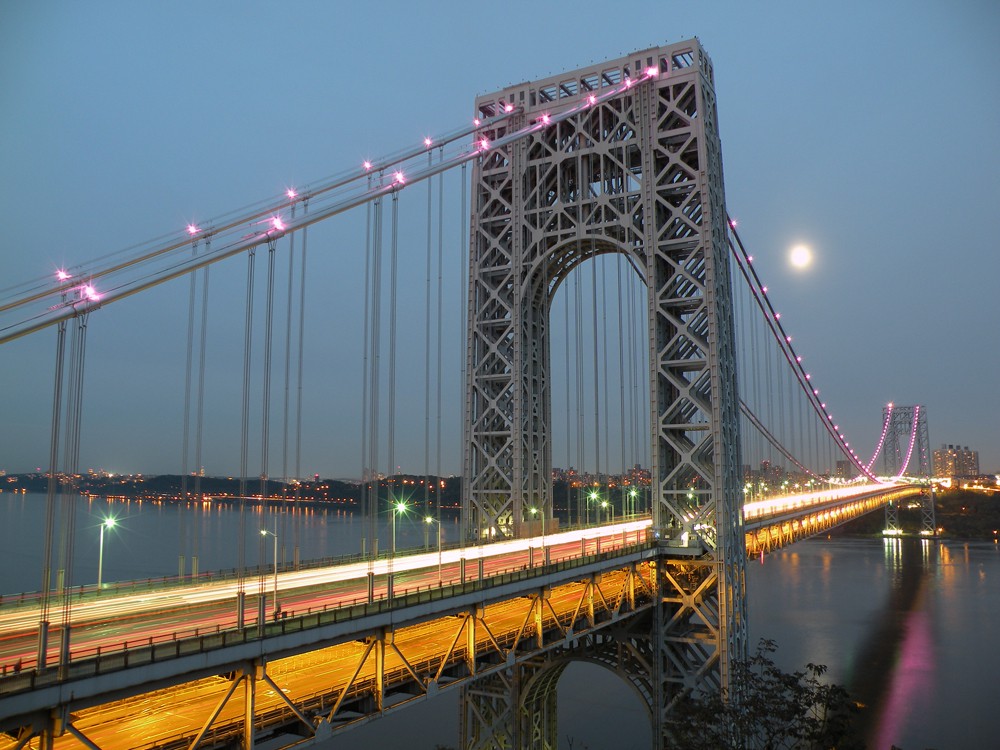 How Many Bridges Are in New York City? The George Washington Bridge
How Many Bridges Are in New York City? The George Washington Bridge
The George Washington Bridge is a double-decked suspension bridge spanning the Hudson River, connecting the New York City borough of Manhattan with the New Jersey borough of Fort Lee. The bridge is named after George Washington, the first president of the United States. The George Washington Bridge is the world?s busiest motor vehicle bridge, carrying over 103 million vehicles per year in 2016. It is owned by the Port Authority of New York and New Jersey, a bi-state government agency that operates infrastructure in the Port of New York and New Jersey. The George Washington Bridge is also informally known as the GW Bridge, the GWB, the GW, or the George, and was known as the Fort Lee Bridge or Hudson River Bridge during construction.
The George Washington Bridge measures 4,760 feet (1,450 m) long and has a main span of 3,500 feet (1,100 m). It had the longest main bridge span in the world at the time of its opening and held that distinction until the opening of the Golden Gate Bridge in 1937.
The Manhattan Bridge
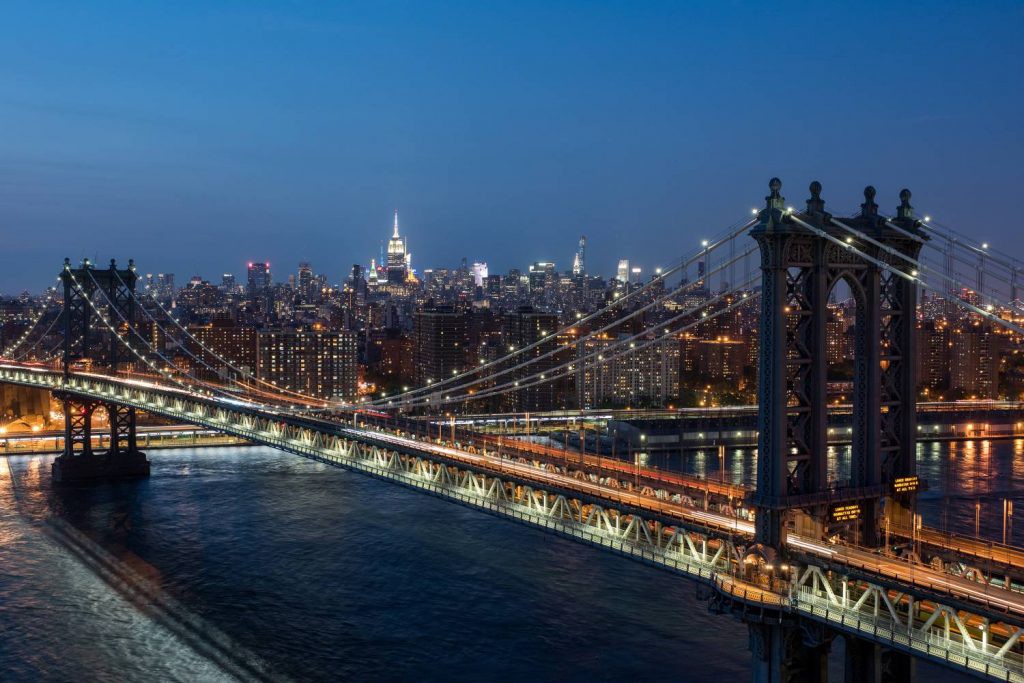 How Many Bridges Are in New York City? The Manhattan Bridge
How Many Bridges Are in New York City? The Manhattan Bridge
The Manhattan Bridge is a suspension bridge that crosses the East River in New York City, connecting Lower Manhattan at Canal Street with Downtown Brooklyn at the Flatbush Avenue Extension. The main span is 1,470 ft (448 m) long, with the suspension cables being 3,224 ft (983 m) long. The bridge?s total length is 6,855 ft (2,089 m). It is one of four toll-free vehicular bridges connecting Manhattan Island to Long Island; the nearby Brooklyn Bridge is just slightly further downtown, while the Queensboro and Williamsburg Bridges are to the north.
The bridge was designed by Leon Moisseiff, built by The Phoenix Bridge Company, and opened to traffic on December 31, 1909. An innovative design, it was the first suspension bridge to employ Josef Melan?s deflection theory for deck stiffening, resulting in the first use of a lightly-webbed weight-saving Warren truss for its construction. Considered the forerunner of modern suspension bridges, it served as the model for many of the record-breaking spans built in the first half of the twentieth century.
The Williamsburg Bridge
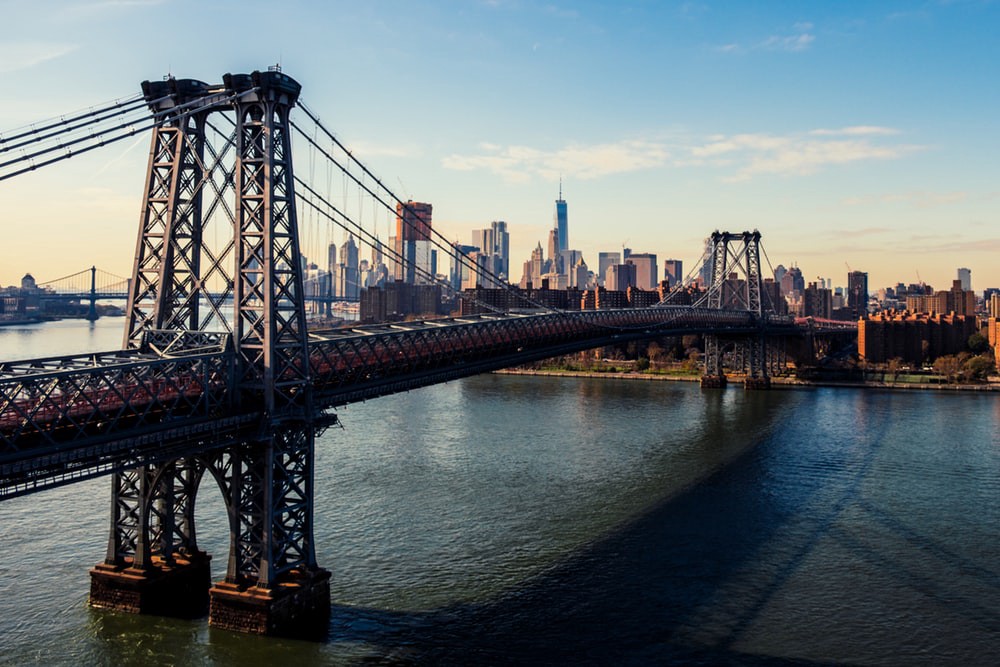 How Many Bridges Are in New York City? The Williamsburg Bridge
How Many Bridges Are in New York City? The Williamsburg Bridge
The Williamsburg Bridge is a suspension bridge in New York City across the East River connecting the Lower East Side of Manhattan at Delancey Street with the Williamsburg neighborhood of Brooklyn at Broadway near the Brooklyn-Queens Expressway (Interstate 278). Completed in 1903, it was the longest suspension bridge span in the world until 1924.
The bridge is one of four toll-free vehicular bridges connecting Manhattan Island and Long Island. The others are the Queensboro Bridge to the north, and the Manhattan and Brooklyn Bridges further downtown. The Williamsburg Bridge once carried New York State Route 27A and was planned to carry Interstate 78, though the planned I-78 designation was aborted by the cancellation of the Lower Manhattan Expressway and Bushwick Expressway.
The Robert F. Kennedy/Triborough Bridge
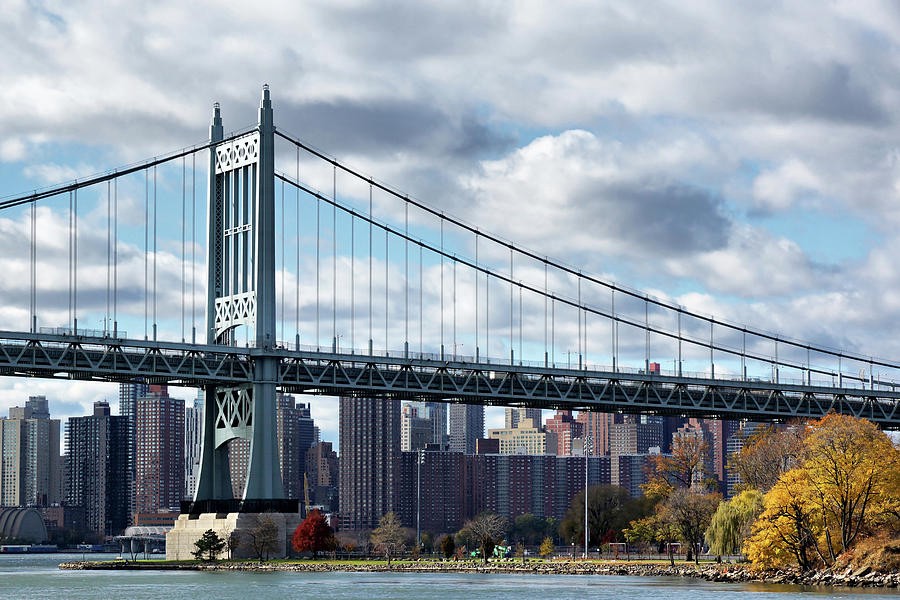 How Many Bridges Are in New York City? The Robert F. Kennedy/Triborough Bridge
How Many Bridges Are in New York City? The Robert F. Kennedy/Triborough Bridge
The Triborough Bridge (known officially as the Robert F. Kennedy Bridge, and sometimes referred to as the RFK Triborough Bridge, the RFK Bridge, or simply the RFK) is a complex of bridges and elevated expressway viaducts in New York City. The bridges link the New York City boroughs of Manhattan, Queens, and the Bronx. The viaducts cross Randalls and Wards Islands, which were previously two islands but are now joined by landfill.
The Triborough Bridge, a toll bridge, carries Interstate 278 as well as the unsigned highway New York State Route 900G. It connects with the FDR Drive and the Harlem River Drive in Manhattan, the Bruckner Expressway (I-278) and the Major Deegan Expressway (Interstate 87) in the Bronx, and the Grand Central Parkway (I-278) and Astoria Boulevard in Queens.
Three bridges are connected by an elevated highway viaduct across Randalls and Wards Islands and 14 miles (23 km) of support roads. The viaduct includes a smaller span across the former site of Little Hell Gate, which separated Randalls and Wards Islands. Also part of the complex is a grade-separated T-interchange on Randalls Island, which sorted out traffic in a way that ensured that drivers paid a toll at only one bank of tollbooths. The tollbooths have since been removed, and all tolls are collected electronically at the approaches to each bridge.
The Kosciuszko Bridge
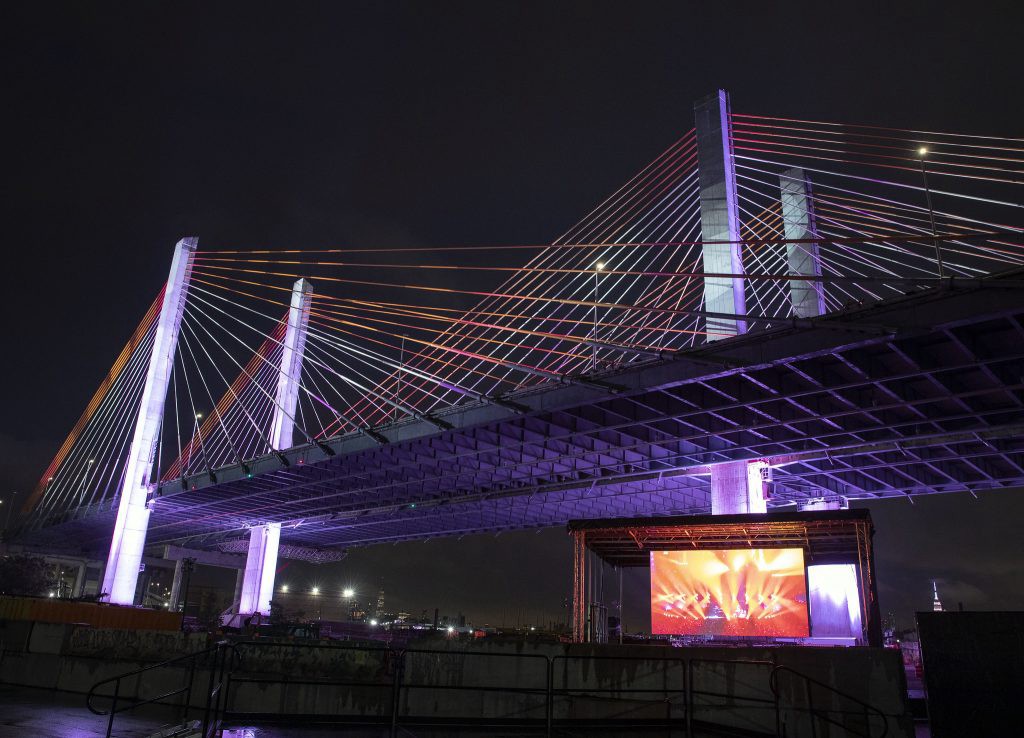 How Many Bridges Are in New York City? The Kosciuszko Bridge
How Many Bridges Are in New York City? The Kosciuszko Bridge
The Kosciuszko Bridge is a cable-stayed bridge over Newtown Creek in New York City, connecting Greenpoint in Brooklyn to Maspeth in Queens. The bridge consists of a pair of cable-stayed bridge spans: the eastbound span opened in April 2017, while the westbound span opened in August 2019. An older bridge, a truss bridge of the same name that was located on the site of the westbound cable-stayed span, was originally opened in 1939 and was closed and demolished in 2017. The crossing is part of the Brooklyn?Queens Expressway (BQE), which carries Interstate 278.
The older truss bridge replaced a swing bridge called the Meeker Avenue Bridge, which connected Meeker Avenue in Brooklyn to Laurel Hill Boulevard in Queens. The old Kosciuszko Bridge, originally also called the Meeker Avenue Bridge, carried six lanes of traffic, three in each direction. In 1940, a year after opening, the bridge was renamed after Polish-Lithuanian military leader Tadeusz Ko?ciuszko, who fought alongside the Americans in the American Revolutionary War.
In 2014, a contract was awarded and work begun to build one of two replacement bridges with more capacity, with the first bridge initially carrying bidirectional traffic. The replacement bridges have the same name as the original bridge, and are both cable-stayed bridges that will each carry one direction of traffic. The first bridge, located south of the old truss bridge, opened on April 27, 2017, with three lanes in each direction. Once the old bridge was demolished via controlled explosion in October 2017, a new westbound cable-stayed bridge with four lanes and a bike/pedestrian path started construction on the site of the old bridge. The first cable-stayed bridge became eastbound-only with five lanes when the westbound bridge opened on August 29, 2019.
The Henry Hudson Bridge
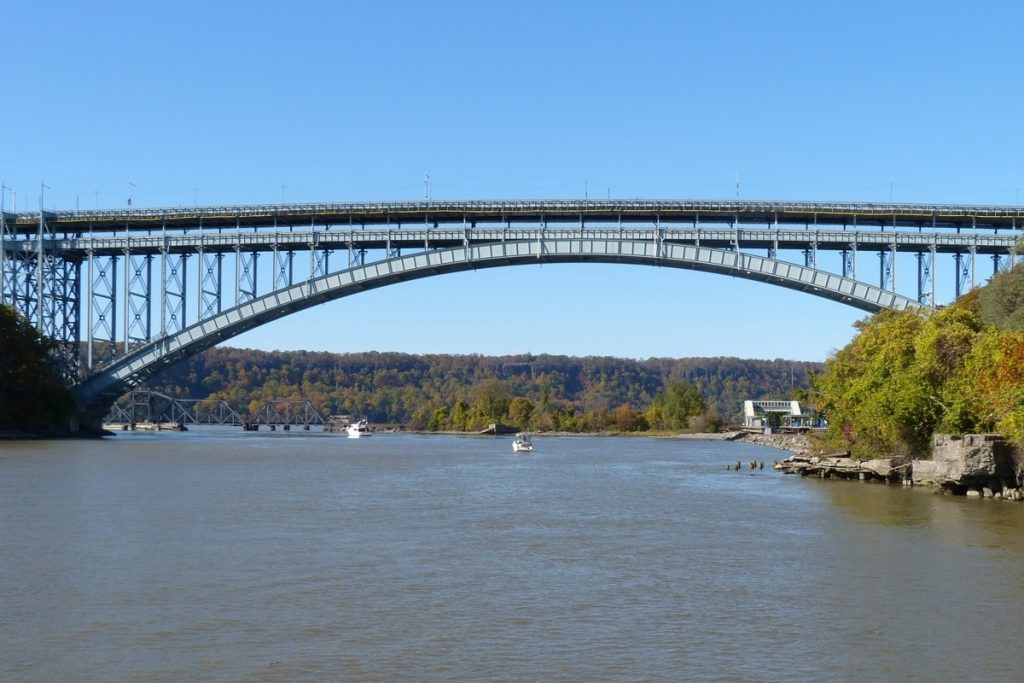 How Many Bridges Are in New York City? The Henry Hudson Bridge
How Many Bridges Are in New York City? The Henry Hudson Bridge
The Henry Hudson Bridge is a steel arch toll bridge in New York City across the Spuyten Duyvil Creek. It connects Spuyten Duyvil in the Bronx with Inwood in Manhattan to the south, via the Henry Hudson Parkway (NY 9A). On the Manhattan side, the parkway goes into Inwood Hill Park. Commercial vehicles are not permitted on this bridge, since commercial vehicles are not allowed on the parkway in general.
The Bronx-Whitestone Bridge
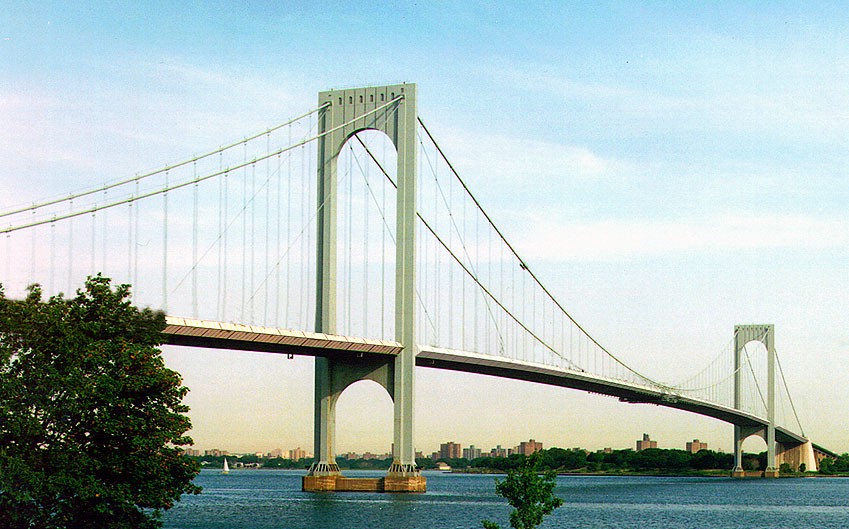 How Many Bridges Are in New York City? The Bronx-Whitestone Bridge
How Many Bridges Are in New York City? The Bronx-Whitestone Bridge
The Bronx?Whitestone Bridge (colloquially referred to as the Whitestone Bridge or simply the Whitestone) is a suspension bridge in New York City, carrying six lanes of Interstate 678 over the East River. The bridge connects Throggs Neck and Ferry Point Park in the Bronx, on the East River?s northern shore, with the Whitestone neighborhood of Queens on the southern shore.
Although the Bronx?Whitestone Bridge?s construction was proposed as early as 1905, it was not approved until 1936. The bridge was designed by Swiss-American architect Othmar Ammann and opened to traffic with four lanes on April 29, 1939. The bridge?s design was similar to that of the Tacoma Narrows Bridge, which collapsed in 1940. As a result, extra stiffening trusses were added to the Bronx?Whitestone Bridge in the early 1940s, and it was widened to six lanes during the same project. The Bronx?Whitestone Bridge was also renovated in 1988?1991 to repair the anchorages, roadways, and drainage. The stiffening trusses were removed during a renovation in the mid-2000s, and the bridge?s deck and approach viaducts were replaced soon afterward.
The Bronx?Whitestone Bridge is owned by New York City and operated by MTA Bridges and Tunnels, an affiliate agency of the Metropolitan Transportation Authority. With a center span of 2,300 feet (700 m), the Bronx?Whitestone Bridge once had the fourth-largest center span of any suspension bridge in the world. The bridge has a total length of 3,700 feet (1,100 m), and its towers reach 377 feet (115 m) above water level.
